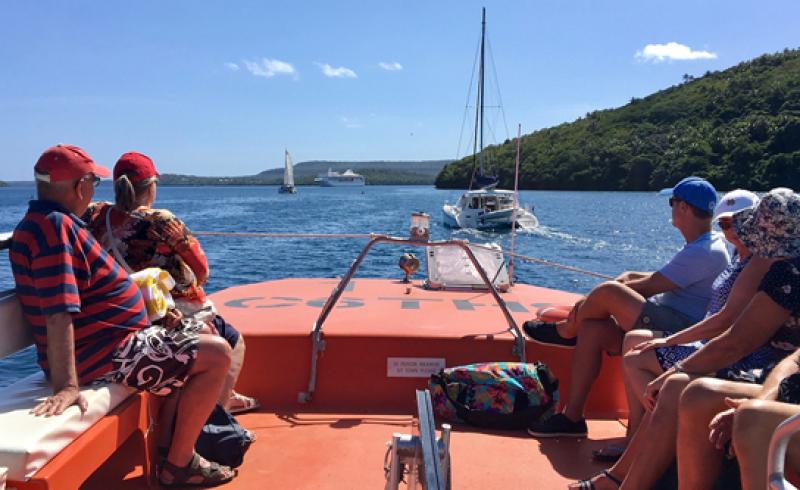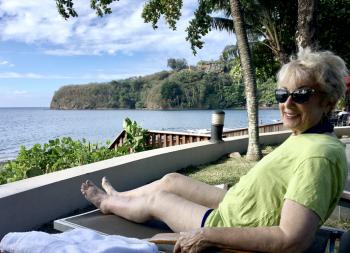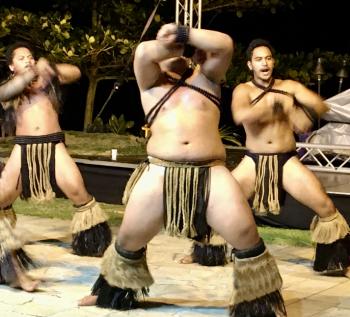Fiji to Tahiti aboard MS Paul Gauguin
This item appears on page 12 of the September 2020 issue.
Ever since seeing the epic 1958 film “South Pacific,” I’ve enjoyed a rich, exotic fantasy founded on travel posters of South Pacific islands. Along with my wife, Marcia, I finally had a chance to fulfill this fantasy when we took the 12-day cruise “Fiji, Tonga, Cook & Society Islands,” Sept. 21-Oct 2, 2019, booked with Paul Gauguin Cruises (Bellevue, WA; 800/848-6172, pgcruises.com).
We paid $10,220 per person for a mid-ship outside stateroom (Deck 6, Category D) with a balcony. Along with transfers and all food and booze for 12 nights, the price included international flights on Air Tahiti Nui. This was a special treat, as Air Tahiti Nui operated 787-9s (Boeing’s Dreamliner). In economy class, the seats were configured 3-3-3, with a respectable 31-inch pitch.
With shadeless windows that dim electronically, the Dreamliner is likely the most efficient airplane aloft today, flying faster and providing a more agreeable cabin climate. The overnight flight from Los Angeles to Fiji was 5,500 miles and took 10½ hours. The return flight from Tahiti was 4,100 miles and lasted almost nine hours.
The MS Paul Gauguin, a 504-foot-long, destroyer-sized ship, is ideal for cruising South Pacific atolls. It holds only 332 passengers in 166 staterooms. The generous cabinetry in each stateroom and numerous balconies are notable. When built in 1997, this ship was likely the height of small-ship sailing elegance.
(While under way, the cruise firm Paul Gauguin Cruises and its sole ship were acquired by Compagnie du Ponant, a French cruise ship operator that had nine sailing ships and plans for expanding to 14. The ship was scheduled for a May 2020 visit to dry dock in Singapore for technical modernizing and a cosmetic upgrade.)
On our cruise, the ship had a largely Filipino crew and an impressive crew/passenger ratio, with one crewman per 1½ passengers, which meant superior attention, with nothing left wanting.
The ship’s food, either buffet or served, was plentiful and varied. The wait service in three restaurants rivaled the best.
The ship’s baker produced spectacular fresh breads, rolls and other delectables. Five soups were offered each day, two for lunch and three for supper. With a selection of hot and cold soups for 13 days, I reveled in soup heaven without a single repeat performance. (I love soup!)
Most of the passengers on our sailing were American; the others were from Europe, Australia and New Zealand. There were very few young children. We found the social mixing to be informal and effortless. We were astounded at the number of passengers who had taken multiple previous cruises on this very ship.
We sailed east from Fiji to Tahiti along the 15-degree south latitude line. (Crossing the International Date Line resulted in a rare treat of two consecutive Thursdays.) The trip included four days at sea, including one 800-mile jaunt.
On board while at sea, talented entertainment was presented nightly, and we palled around with the two British singing groups and an Italian magician. There were occasional lectures on various subjects, including history and sociology, and I could have absorbed even more. Tours of the ship’s kitchen, bridge and engine spaces were available on request.
For additional fees, Paul Gauguin Cruises offered a selection of land tours at each destination, with options for snorkeling, beaching, zip-lining, e-biking or visiting a resort, village or waterfall.
Early in the cruise, at the stern, Marcia and I and the other passengers picked up swim fins, masks and snorkels, which we retained for the duration of the journey. We could snorkel from the stern, from numerous beaches accessed by tender or on paid excursions.
The magic of snorkeling in pristine turquoise water is spectacular and in total agreement with any travel-poster fantasy.
The South Pacific islands are volcanic products of ancient subduction zones where tectonic plates grind together, forcing one under the other. Some islands still have cinder cones, thermal volcanic activity and black sand.
The nine island destinations we experienced included three locations each in Fiji, Tonga and the Cook Islands and four in the Society Islands, specifically Bora Bora, Taha’a, Mo’orea and, in Tahiti, Papeete. As we proceeded to Tahiti, the islands seemed to increase in their seductive beauty while maximizing water sports like snorkeling.
Most of our island stops had three appealing characteristics: (1) they were typically bypassed by most cruise ships, (2) they had magnificent, enormous shallow lagoons surrounded by lips of coral reefs and dominated by craggy mountains and (3) they were not honky-tonk tourist traps; they were the “real deal” of South Pacific society.
Most of the ports were very small, with limited capabilities, and could be approached only via tenders. Thankfully, it appeared they have been unspoiled by mass tourism. Refreshingly, it seemed that the residents of some islands (such as Tonga) could happily care less about tourism. Such is the laid-back lifestyle.
Of the islands we visited, I would most recommend Mo’orea and Bora Bora, where the South Seas magic is at its highest.
The principal message of our experience was not the cruise but the people. The Fiji tradition of saying “Bula” to every passing person was contagious. On the ship, on every island and with every interaction, we were treated to a regional epidemic of hospitality and gracious courtesies of the highest order.
We were glad we were able to satisfy our wanderlust and learn about life in the South Pacific — so very refreshingly different.
STEVE PLOTKIN
Newtown Square, PA





